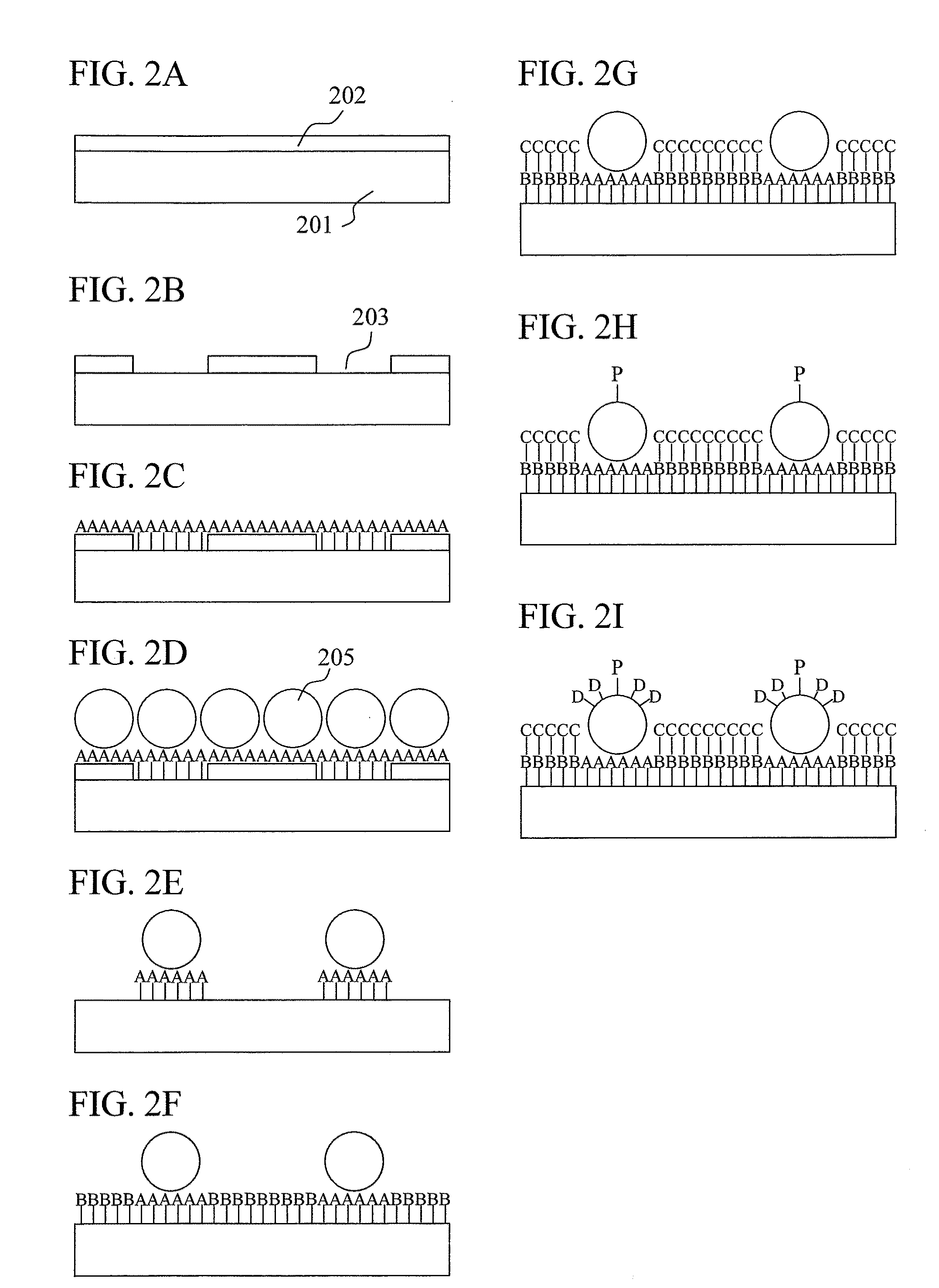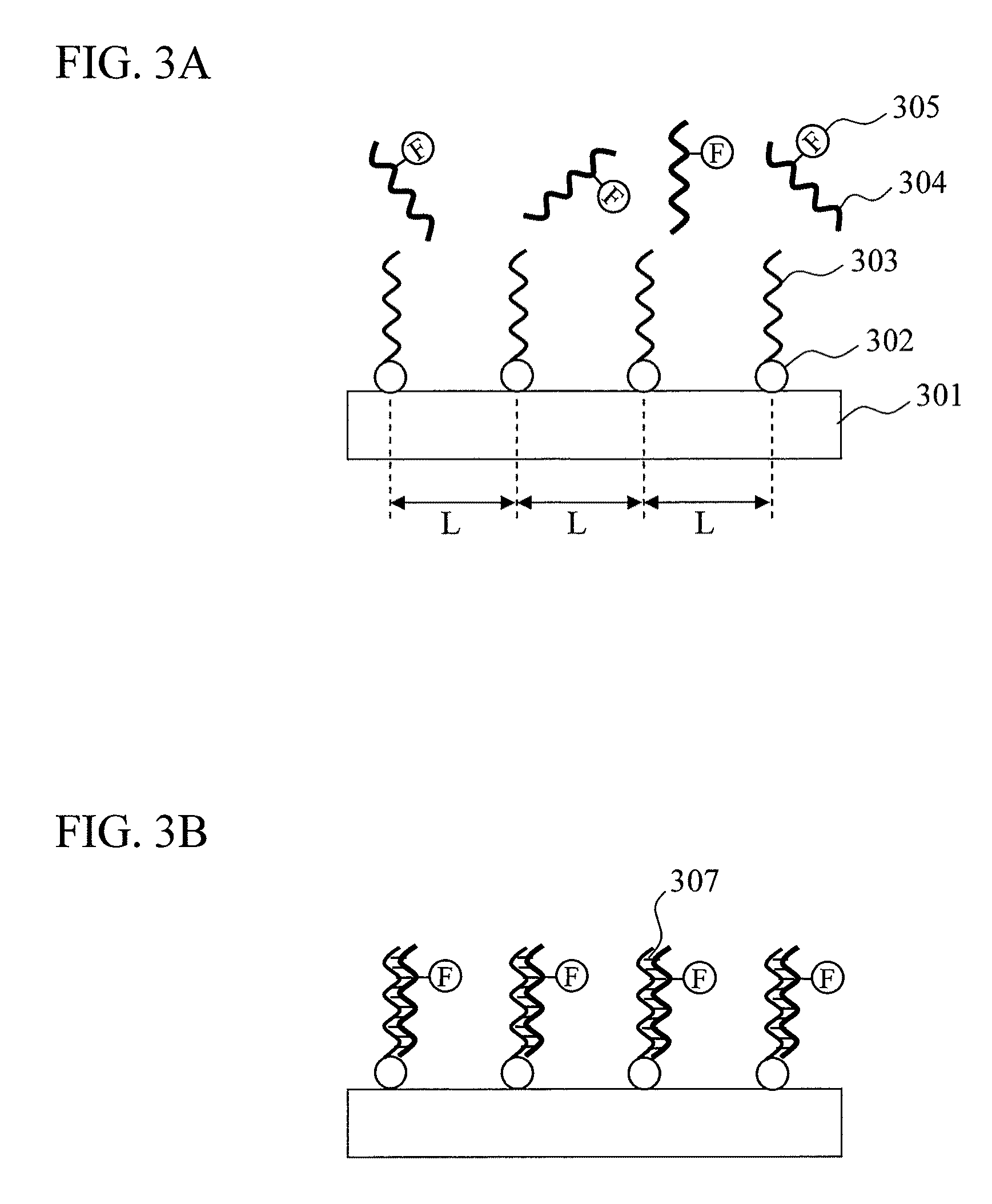Biomolecule sensor, method for manufacturing the same, biomolecule detection method, and biomolecule detection system
a biomolecule sensor and sensor technology, applied in the field of biomolecule sensor for detecting a biomolecule, can solve the problems of insufficient fixing stability of microparticles, inability to provide stable performance of devices, and difficulty in obtaining one-to-one correspondence between one pixel and a spatial arrangement of a dna molecule, so as to improve fluorescence detection sensitivity and improve reproducibility. the effect of detection accuracy
- Summary
- Abstract
- Description
- Claims
- Application Information
AI Technical Summary
Benefits of technology
Problems solved by technology
Method used
Image
Examples
example 1
(Step 1) Coating Step of Positive-Type EB Resist on Substrate Surface: FIG. 11A
[0106]A Si substrate having a diameter of 4 inches (about 102 mm) provided with a highly flat thermally-oxidized film of 100 nm was used in the place of a carrier substrate 1101. The substrate was washed with a 0.1 wt % NaOH solution, further washed with a 0.1 wt % HCl solution, rinsed with pure water, and then dried. A main chain scission-type positive-type resist was used as the resist in this example. After being diluted with anisole, the resist was coated on the substrate using a spin coater. After coating, the substrate was baked at 180° C. in an N2 flow for 20 minutes for removal of the solvent. In this example, a resist film thickness of 60 nm, which is sufficiently thin and is not worn out by the EB processing, was adopted (resist:anisole=1:3 dilution). In order to prevent charging of the substrate during the EB lithography, a conductive polymer (polyisothianaphthene sulfonate) solution was coated...
example 2
[0124]In order to measure a concentration detection limit of DNA microarray, a gold nanoparticle grid array having single probe DNAs fixed thereon was prepared in the same methods described in Steps 1 to 9 in Example 1. Meanwhile, a conventional array was prepared similarly in the method described in Example 1. Hybridization was performed in Step 10 described in Example 1.
[0125]In this example, the amount of completely complementary target DNAs having fluorescent molecules bound thereto in the hybridization was varied in a range from 1 amol to 1 fmol. The relationship between the fluorescence intensity and the amount of target DNAs was investigated for each array. The result suggested, as shown in FIG. 16, that the gold nanoparticle grid array had improved detection sensitivity for target DNA compared to the conventional array. While the detection limit of the conventional array was 100 amol, the detection limit of the gold nanoparticle grid array was 1 amol; thus, the sensitivity w...
example 3
[0126]This example shows a case of using the present invention in DNA sequencing. A substrate for DNA sequencing was prepared according to Steps 1 to 8 described in Example 1 for the DNA sequencing. In this example, a quartz substrate was used in the place of the Si substrate. In the formation of openings by the EB lithography and development in Step 2, a pattern having openings of 40 nm φ arranged in a grid form at pitches of 1 μm was prepared. With this pattern, gold nanoparticles were aligned in the grid form at pitches of 1 μm. A scanning electron microscopic (SEM) observation result of the gold nanoparticle grid array substrate thus prepared is shown in FIG. 17. It was confirmed that the gold nanoparticles of 30 nm φ were aligned at pitches of 1 μm. Accordingly, if a CCD camera for detecting fluorescence intensity has a pixel size of 1 μm2, it is possible to detect a fluorescence signal from one DNA molecule with one pixel in the sequencing process. A fluorescence signal from a...
PUM
| Property | Measurement | Unit |
|---|---|---|
| particle size | aaaaa | aaaaa |
| thickness | aaaaa | aaaaa |
| thickness | aaaaa | aaaaa |
Abstract
Description
Claims
Application Information
 Login to View More
Login to View More - R&D
- Intellectual Property
- Life Sciences
- Materials
- Tech Scout
- Unparalleled Data Quality
- Higher Quality Content
- 60% Fewer Hallucinations
Browse by: Latest US Patents, China's latest patents, Technical Efficacy Thesaurus, Application Domain, Technology Topic, Popular Technical Reports.
© 2025 PatSnap. All rights reserved.Legal|Privacy policy|Modern Slavery Act Transparency Statement|Sitemap|About US| Contact US: help@patsnap.com



